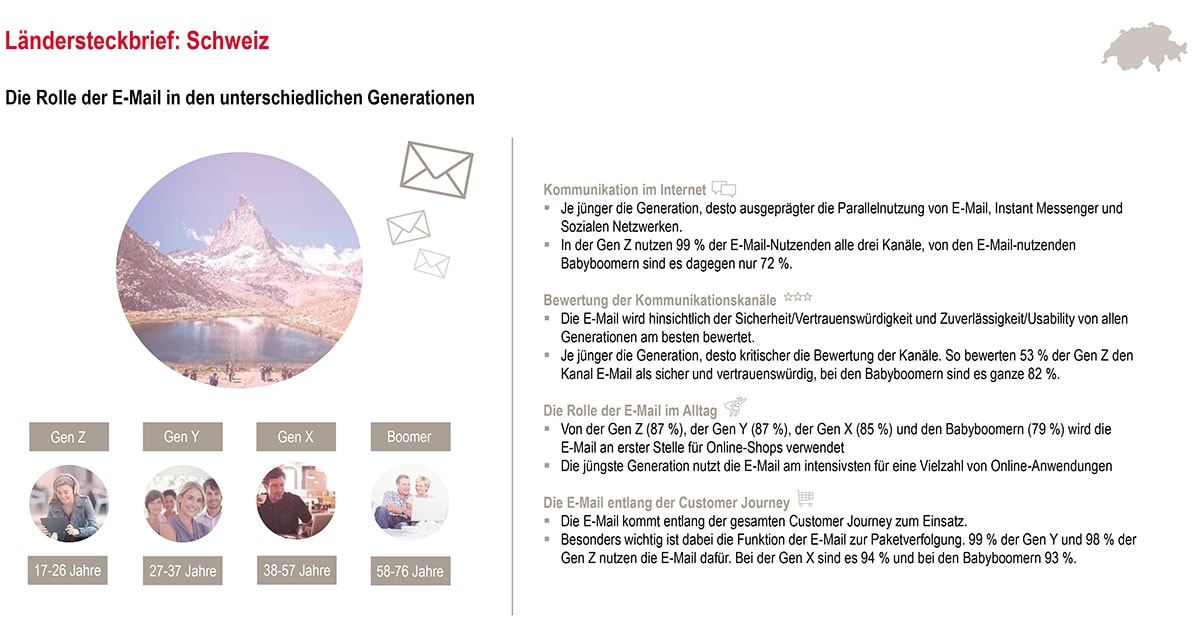Study shows: e-mail marketing remains indispensable
As part of a DACH study, United Internet Media examined e-mail use across the generations. In all three countries, the digital mailbox is ahead of instant messengers and social networks in terms of security, trustworthiness and reliability. In addition, Gen Z and Gen Y use e-mail far more frequently than Gen X and baby boomers.

Investments in dynamic e-mail marketing and target-group-specific communication and content are worthwhile. This is shown by the current DACH study "E-Mail Cross Generations" commissioned by United Internet Media. The reasons for this lie in the different use of e-mail, both at country and generation level. For the study, the market research institute MindTake surveyed over 1,000 people in Germany, Austria and Switzerland.
One core result for the DACH region across all generations: electronic mail is indispensable. If respondents can only choose one application, 24 percent opt for e-mail. Other Internet services register lower values: they are followed by instant messenger (22 percent), online banking (19 percent), search engine (12 percent) and social networks (7 percent).
In the detailed analysis at country level, e-mail is also always named most frequently when asked about the indispensability of individual Internet applications. 24 percent of respondents from Germany declared e-mail to be indispensable, which is exactly in line with the average; in Austria, the figure is 22 percent, and in Switzerland, 27 percent. The indispensability can be attributed to the high use of the digital mailbox in the DACH region: Around 90 percent of online users in Germany and Austria said they frequently or occasionally send and receive private e-mails. Among online users in Switzerland, as many as 98 percent said the same.
E-mail is the basis of Internet use
In the DACH region, e-mail serves as the basis of everyday digital life for all generations. The trend is that the younger the generation, the more varied the use of e-mail. Baby boomers use the electronic mailbox most frequently for logging into online stores (81 percent), online banking (71 percent) and online payment services (69 percent). For Gen X, the top uses are online stores (84 percent), online payment services (76 percent), and online banking and social networking (70 percent each). Gen Y uses email most for online stores (86 percent), social networks (83 percent) and online payment services (79 percent). In Gen Z, email scores highest for online shopping (88 percent), video streaming (84 percent) and social networking (83 percent).
"The cross-generation use of e-mail is impressively demonstrated by the study. At the same time, it shows the versatility and relevance of the electronic mailbox for virtually all industries. The country- and generation-specific features show that investing in dynamic e-mail marketing with content tailored to target groups is worthwhile," says Rasmus Giese, CEO of United Internet Media.
In Austria, the use of e-mail in connection with public institutions (baby boomers: 71 percent, Gen X: 70 percent, Gen Y: 73 percent Gen Z: 66 percent) is far higher than in neighboring countries. In Switzerland, on the other hand, electronic mail provides above-average support for app store activities (baby boomers: 57 percent, Gen X: 70 percent, Gen Y: 78 percent Gen Z: 86 percent). On the other hand, Germans use the P.O. box far more intensively for online auctions (baby boomers: 60 percent, Gen X: 68 percent, Gen Y: 71 percent Gen Z: 69 percent) than respondents in Austria and Switzerland.
Customer journey almost unthinkable without email
Email practically always plays a role in the digital purchasing process: Nine out of ten respondents in the DACH region use their email address during the customer journey. The individual touchpoints also register very high usage values: 90 percent are made aware of new products via e-mails such as newsletters. 91 percent use e-mail to register, and 88 percent contact retailers by e-mail with questions about the product. Another 91 percent email customer service, and 94 percent use email to track packages. Of particular importance to retailers, 73 percent of respondents buy products advertised in an email.
"Compared to other advertising channels, e-mail has an excellent price-performance ratio. And e-mail works - almost three quarters of respondents buy products advertised in newsletters. This willingness to buy can also be supported at the various touchpoints - adapted to the respective age, for example, on the basis of first-party data, if desired," says UIM CEO Giese.
At the generational level, Gen Y and X have the highest values at the beginning of the customer journey. For example, 95 percent of Gen Y use their e-mail address to register with stores or price comparison sites. The highest value for parcel tracking by e-mail is recorded by Gen Z with 97 percent. Two trends can be identified at country level: In Switzerland and Germany, e-mail is used most intensively by Generation Y along the customer journey. In Austria, in addition to the younger generations Z and Y, Gen X also achieves the highest usage values in points such as communication with retailers and customer service.
Email is evaluated as secure and trustworthy
The study also surveys how online users in the DACH region rate the individual communication channels. In terms of "security & trustworthiness" and "reliability & usability," e-mail is ahead of instant messengers and social networks in all three countries.
The following two trends can be observed in Germany, Austria and Switzerland: The older the generation, the stronger the expectation of security and trustworthiness in private communication on the Internet. 81 percent of baby boomers consider e-mail to be secure and trustworthy - instant messengers (68 percent) and social networks (62 percent) score significantly lower. Gen Z rates the communication channels most critically across three DACH countries. But here, too, email scores far better than instant messenger (53 percent) and social networks (49 percent), at 59 percent.













